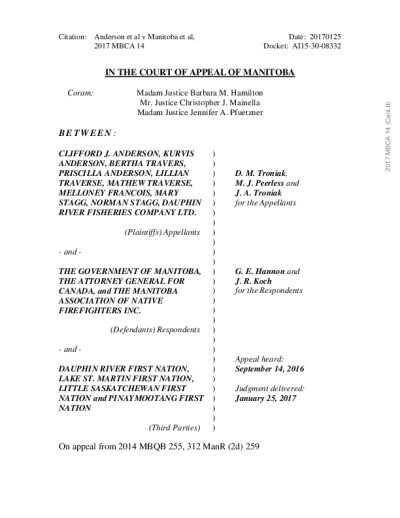
Date
Geographical Area
North America
Countries
Canada
Keywords
Case Name
Anderson et al. v Manitoba et al
Case Reference
2017 MBCA 14
Name of Court
Manitoba Court of Appeal
Key Facts
In 2011, a devastating flood occurred in parts of Manitoba, including the land around the waterway between Lake Manitoba and Lake Winnipeg. Some of this land included reserves belonging to Pinaymootang First Nation, Little Saskatchewan First Nation, Lake St. Martin First Nation, and Dauphin River First Nation. The representative plaintiffs in this case are members of four First Nations in Manitoba affected by this flooding in 2011. They allege that the Government of Manitoba’s improper operation of a dam and specific other water control structures diverted excess water onto their lands causing extensive property damage and requiring many to be evacuated from their homes. The plaintiffs framed their claims against Manitoba in nuisance, negligence, breach of treaty rights, and fiduciary duty.
The Manitoba Court of Queen’s Bench found that the claims in negligence and breach of treaty rights contained common issues but that the claims did not have common issues concerning nuisance and breach of fiduciary duty. The certification judge’s reasoning was based on his view that many of the proposed class members may not have been affected by the flooding. As the Court considered that the nuisance claim was a significant cause of action to the plaintiffs, the Court reasoned that a class proceeding was not the preferable procedure to resolve the common issues that did exist. Hence, the Manitoba Court of Queen’s Bench dismissed the application.
The Manitoba Court of Queen’s Bench found that the claims in negligence and breach of treaty rights contained common issues but that the claims did not have common issues concerning nuisance and breach of fiduciary duty. The certification judge’s reasoning was based on his view that many of the proposed class members may not have been affected by the flooding. As the Court considered that the nuisance claim was a significant cause of action to the plaintiffs, the Court reasoned that a class proceeding was not the preferable procedure to resolve the common issues that did exist. Hence, the Manitoba Court of Queen’s Bench dismissed the application.
Decision and Reasoning
The plaintiffs sought and obtained leave to appeal on the questions of whether the certification judge applied the correct legal test to the question of a standard-issue concerning nuisance and, if not, whether that error affected his decision on the question of preferability. The plaintiffs succeeded in the appeal concerning both issues.
The Court of Appeal held that a class proceeding would be the preferable procedure for the fair and efficient resolution of the common issues. Therefore, the Court of Appeal allowed the appeal and ordered that the issues relating to nuisance, negligence, and breach of treaty rights be certified as a class proceeding. There was no order as to costs.
The Court of Appeal held that a class proceeding would be the preferable procedure for the fair and efficient resolution of the common issues. Therefore, the Court of Appeal allowed the appeal and ordered that the issues relating to nuisance, negligence, and breach of treaty rights be certified as a class proceeding. There was no order as to costs.
Outcome
At the time of writing, Manitoba has not sought leave to appeal to Canada’s Supreme Court.
Disclaimer
This case law summary was developed as part of the Disaster Law Database (DISLAW) project and is not an official record of the case.
Document
Document